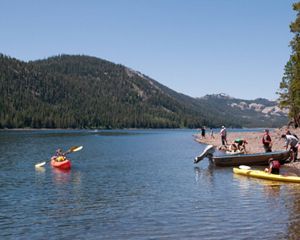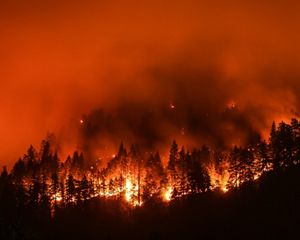Shasta River
California

To make salmon restoration truly successful, we often must balance the needs of foresters and ranchers with the habitat requirements of salmon.
In California, many of the rivers, streams and estuaries on which salmon depend run through working landscapes that generate income for people. The Shasta River is vital habitat for coho and Chinook salmon, but the river is also an essential source of irrigation water for local agriculture operations. In a region where the relationship between agriculture and salmon has long been characterized by conflict, The Nature Conservancy saw an opportunity for collaboration.
Species in Crisis
Wild salmon are known for overcoming incredible obstacles: their epic migrations take them on thousand-mile journeys and bring them face to face with some of nature’s fiercest predators. But in northern California, the odds are growing too great for salmon to overcome. Here, the salmon populations face a number of challenges ranging from warm river temperatures to reduced streamflows.
Once-thriving populations of fish are declining—seven of the 10 coastal California salmon and steelhead species are federally threatened or endangered. Now, this emblem of California’s rich natural legacy could disappear forever, taking with them one of the state’s most economically crucial industries.
Taking Action for People and Fish
That’s why TNC is acting throughout the Shasta Valley to protect streams that serve as salmon habitat. TNC bought land in the Shasta Valley first in 2005 and then again in 2009, purchasing a total of 6,200 acres collectively known as Shasta Big Springs Ranch. In addition to being a working cattle ranch, the property contains eight miles of the upper Shasta River as well as two miles of a connected creek. This part of the river is a breeding ground for Chinook and coho salmon, so its protection and restoration was essential.
Shasta Big Springs Ranch under TNC’s stewardship became a living laboratory demonstrating that through science and partnership, cattle ranching and salmon can thrive side by side.
TNC and its partners restored 10 miles of river, planted 6,000 native riparian trees, invested in more than 60 scientific research projects and implemented new practices developed to improve salmon habitat by decreasing water temperatures and increasing stream flows, all while running an active cattle ranch. We hosted hundreds of schoolchildren and members of the community at events designed to share firsthand the wonder of salmon returning to their natal spawning grounds. And to share this incredible natural phenomenon with people far beyond the local community, we installed an underwater camera during spawning season that enabled the public to watch 30,000 Chinook return to the river, a record in recent years.
Looking Forward
Completing our restoration work and accomplishing our goal of proving methods by which salmon and ranching can successfully coexist enabled us to shift our focus to other initiatives in the watershed. We can now scale our work in the area to work with other agricultural partners and reduce conflicts between salmon and ranching.
The innovative work we have done at Shasta Big Springs Ranch has established the foundational science for fish-friendly ranching, which continues to inform conservation projects and strategies we are developing in partnership with farmers and ranchers across the state with the goal of meeting the needs of both nature and people.
Meet the Salmon Species in the Shasta River
- Coho: Coho salmon of southern Oregon/northern California are in severe decline, listed as threatened by the state of California in 2004.
- Chinook: Once estimated as high as 82,000 fish, this species has dropped to runs below 100 in this century. These fish now hover around the 5,000 mark.
- Winter Steelhead: While counts of adult steelhead are lacking for most of the 20th century, they were historically abundant in the river.
Opportunities for Visitors
Camp, hike, swim, fish or view wildlife at one of the many local, state and national parks, including the Klamath National Forest, the Lower Klamath National Wildlife Refuge and the Shasta Valley Wildlife Area.
Make a Difference in California
Together, we can achieve transformative change on a scale that’s attainable—for the Lower Klamath Basin, for California and for the world.


